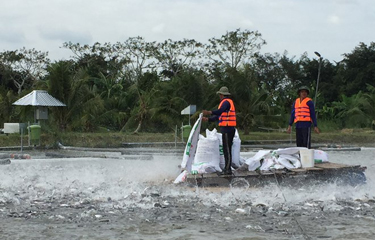The coronavirus has delivered a large blow to Vietnam’s pangasius sector, which was already hurting before the pandemic.
Vietnam has not recorded any COVID-19 deaths through the crisis, and the entire country has only seen around 300 cases of the disease due to the extensive preventative measures it took beginning in January. But while most of social and economic activities in Vietnam have been brought back to a “new normal” since late April, disruptions in foreign markets, tangled supply chains, and suppressed demand have hurt its seafood export sector, upon which the country’s pangasius traders depend heavily.
Even before the coronavirus outbreak, Vietnam’s pangasius traders had struggled with weak demand from major markets and lower material prices. Vietnam exported USD 2 billion (EUR 1.83 billion) worth of pangasius in 2019, down 11.7 percent year-on-year, missing its target of USD 2.3 billion (EUR 2 billion) in sales. A domestic oversupply in Vietnam and high stockpiles in the U.S., one of the most important market for the fish, made it difficult for exporters of pangasius to meet last year’s goals.
While efforts to reduce production are underway, the coronavirus thwarted any chance of a short-term recovery previously hoped by the sector. Pangasius sales in the first quarter of 2020 contracted 29.3 percent year-on-year to USD 334 million (EUR 305 million), as shipments were significantly disrupted due to the pandemic, and a downward trend of exports to most of Vietnam’s major pangasius markets was noted in data provided by the Vietnam Association of Seafood Exporters and Producers (VASEP).
According to VASEP, Vietnam exported pangasius worth USD 449.5 million (EUR 410.3 million) between January and April 2020, down 27 percent from the same period in 2019. The drop in the first four months was partially offset by the increases in sales in April to China (including Hong Kong) – up 20.1 percent from April 2019, as well as Singapore, which saw sales value soar 127.6 percent from April last year, and the United Kingdom, up 20.3 percent year-on-year.
In the first four months of 2020, China imported pangasius worth USD 111.1 million (EUR 101.4 million) from Vietnam, down 20.2 percent year-on-year, but still putting it in the position of being the largest buyer of the fish in the period. After experiencing a lockdown through January and February, customers from China resumed pangasius purchases in March and April, but those imports were directed primarily for stockpiling out of fear that future sales would be restricted by an extension of measures taken by Vietnam in the first half of April to restrict the spread of COVID-19, VASEP said. A slow reopening of restaurants in China has resulted in a drop in sales through this channel, VASEP said, adding that some buyers from China have also pressed exporters from Vietnam to reduce prices.
Exports to the United States, the number-two destination for pangasius from Vietnam, saw a decline of 14.6 percent to USD 74.6 million (EUR 68 million) in value between January and April, as the country struggled with the COVID-19 outbreak. The export value of Vietnamese pangasius contracted 20.7 percent in April, following an increase of 26.4 percent in March. A U.S.-based trader told SeafoodSource his trade in pangasius is minimal at the moment.
“Our sense was we were just seeing the market begin to improve in February, then the virus brought everything to a halt. We do not do too much pangasius at the moment and most of our business is [typically] in the foodservice area,” the trader said. “This was such a popular item in retail just a short time ago. But it seems the species has not yet recovered in that market.”
Vietnamese pangasius sales to the ASEAN bloc also shrank, declining 24.4 percent year-on-year to USD 53 million (EUR 48.4 million) in the first four months of 2020. The value of Vietnam’s exports to Thailand and Malaysia also dropped, registering declines of 30 percent and 31 percent, respectively, in April.
Lockdowns in several European countries also contributed to lower sales of pangasius to the European Union in Q1 2020, with total the export value dropping 36 percent year-on-year to USD 48.3 million (EUR 44 million) between January and April. Declines were seen in most major markets in the bloc, including the Netherlands (down 29 percent year-on-year), Germany (31 percent lower year-on-year), and Belgium (falling 38.8 percent from the first four months of 2019).
Vietnam’s pangasius exports are unlikely to rebound in the second quarter of 2020 due to the continuous spread of the coronavirus in many of its most important markets, but they may recover in the third quarter if the pandemic is contained, VASEP said.
At a conference that took place in early May in An Giang Province, the topic of government support measures to boost pangasius exports was discussed at length.
The Vietnam Pangasius Association said the sector has been hit hard by the COVID-19 pandemic, with declines recorded in farming area, output, export value and prices, the Ministry of Agriculture and Rural Development said in a statement on 8 May. By the end of the conference, there was consensus that pangasius exports will fall sharply compared to 2019. Many of those in attendance expressed fear that exports to most major markets, including the U.S., E.U. and South Korea, are unlikely to rebound until well after the pandemic is over.
Several participants warned that, although there are signs of recovery in the Chinese market, it should be considered as an “unstable, high-risk market” for Vietnam’s pangasius exporters.
Vietnam’s pangasius farmers are already responding to this outlook. Vietnam’s pangasius farming area measured 3,788 hectares at the end of April, down 3.35 percent year-on-year, and total output dropped 11.85 percent to 322,364 metric tons (MT) in the period, data from the General Department of Fisheries shows.
As a result of the decline in exports, material prices in Mekong Delta have been kept at low levels, incurring losses for farmers. The farm-gate prices in the week ending 15 May ranged between VND 18,000 and VND 18,2000 (USD 0.76 to 0.77, EUR 0.70 to 0.71) per kilogram, down around 33 percent year-on-year, according to the Vietnam Industry and Trade Center. The production cost for a kilogram of pangasius ranges from VND 21,000 to VND 22,000 (USD 0.90 to USD 0.94, EUR 0.80 to EUR 0.86), meaning producers are currently losing money on pangasius-farming.
Photo courtesy of VASEP







